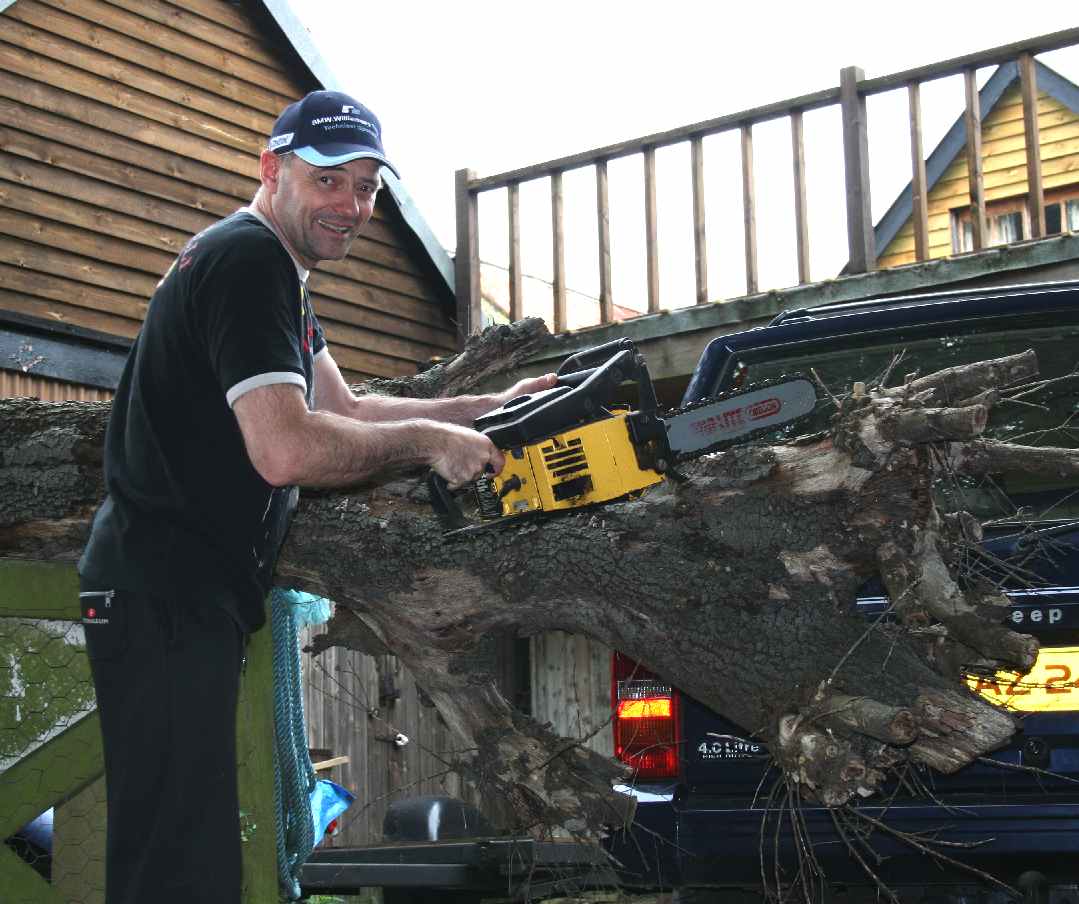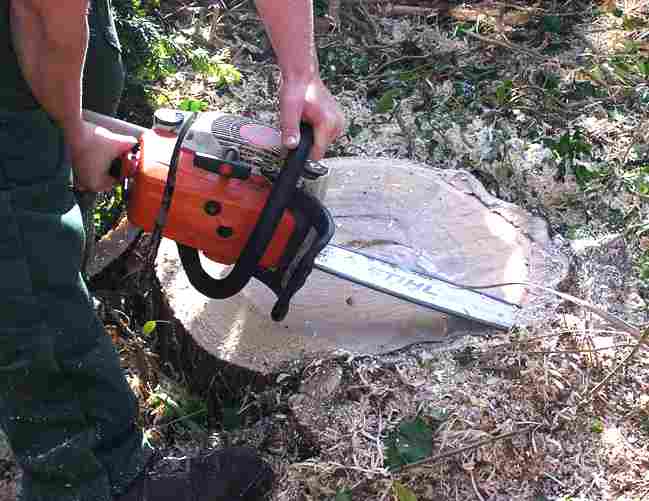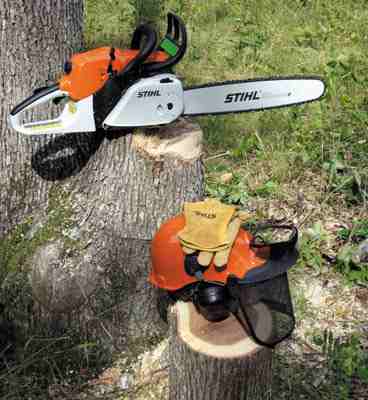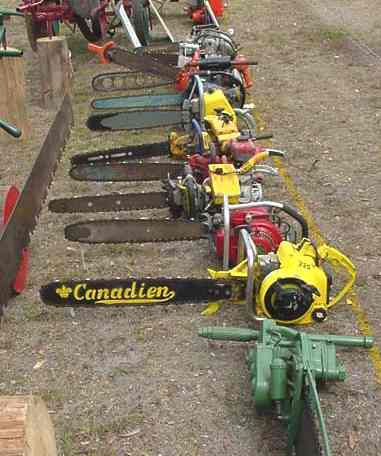|
CHAINSAWS
|
||
|
HOME | BIOLOGY | FILMS | GEOGRAPHY | HISTORY | INDEX | INVESTORS | MUSIC | NEWS | SOLAR BOATS | SPORT |
||
|
The occupiers of a historic building in the village of Herstmonceux in East Sussex, had a lucky escape yesterday evening at about 3:00 am in the morning of Friday 24th August 2007. A wind got up and literally blew a large old oak tree over. In the process, missing a Jeep parked in the drive by inches.
Nelson cutting a trapped Jeep free with a McCulloch chain saw
A chainsaw (also spelled chain saw) is a portable mechanical, motorized saw. It is most commonly used in logging activities such as felling, delimbing, and bucking; by tree surgeons to fell trees and remove branches and foliage; to fell snags and assist in cutting firebreaks in wildland fire suppression, and to harvest firewood. Chainsaws with specially designed blades have been developed as tools for use in chainsaw art.
Construction
Chainsaws consist of a small two-stroke gasoline (petrol) internal combustion engine (although smaller versions sometimes use electric motors), the "guide bar" (essentially a long metal frame of a very hard wearing alloy) and the cutting chain itself. Usually each segment in this chain (which is constructed from riveted metal sections similar to a bicycle chain, but without rollers) features a small sharp blade, called a "tooth." "Skip tooth" chain has a tooth only on every second link, and is used for reduced risk of the chain clogging when cutting very soft wood. In modern saws the teeth are not straight blades; they have a forward section that first chips a piece of wood from the bottom of the cut, then another section, at a right angle to the first, which chips a piece from the wall of the cut. There are left and right handed teeth, depending on which wall of the cut they will chip. Left and right teeth are alternated in the chain.
The underside of each link features a small metal finger that keeps the tooth centered between the rails of the bar, helps to carry lubricating oil around the bar, and engages with the engine's drive sprocket inside the body of the saw. The engine drives the chain around the track at a high speed, providing an effective (if rather rough) cutting action.
As chainsaws become more popular among home owners chainsaw manufacturers are introducing features to make them easier to use. Stihl has developed an Easy2Start, or ErgoStart in Europe, system that uses a spring to overcome the engine's compression. These saws usually start on one pull.
Women are increasingly becoming loggers and foresters. Husqvarna has developed the 339XP as a small saw easy to use for felling and bucking small trees and marketing it towards female foresters. Stihl also sponsors and gives away saws to female chainsaw carvers to promote women in the forest industry. Masters of the Chainsaw has an all women carving demonstration team called the "Chainsaw Chix."
As chainsaw carving becomes more common chainsaw manufacturings are making special short "dime tipped" bars for carving. Echo also sponsors a carving series and carvers like former Runaways singer Cherie Currie. RedMax specifically built the G3200 CV chainsaw for carving applications.
Gasoline (petrol) driven Stihl chain saw
Maintenance
Chainsaws usually require two sources of lubrication. Like most two-stroke engines, the engine is lubricated by its fuel, which contains about 2 ~ 5% (depending on model) oil dissolved in the fuel. Since this mixture is highly flammable, a completely separate oil reservoir is used for the external lubrication of the blade and chain. This latter oil is depleted quickly because it tends to be thrown off the chain by centrifugal force. Failing to keep this reservoir topped up, or using an oil of incorrect viscosity, is a common source of damage to saws and tends to lead to the chain coming off of the bar. With some types of wood, the operator will need to occasionally stop and unplug the holes where the oil is dispensed to the chain and guide bar
The air intake filter tends to clog up with sawdust. This must be cleaned from time to time, but is not a problem during normal operation. Many saw operators clean it with petrol, although manufacturers recommend using compressed air to blow the dust off the filter mesh from the inside, or warm, soapy water, and then left to air dry. If these resources are not available, pure, clean gasoline should be used, otherwise the residual oil on the filter will make it clog up again faster.
Chains must be kept very sharp to perform well. This may be done with a round file or a jig (without removing the chain from the saw), or with a specialised electric sharpening jig with the chain removed from the saw. The jigs help ensure that each cutting face is kept at the correct angles, which are carefully balanced to maximise the saw's efficiency. Proper hand-sharpening may produce a better result, but electric sharpeners are faster, particularly when sharpening very dull chains (especially those which have been subjected to dirt, metal or rocks). Carbide chainsaw blades cannot be sharpened by conventional sharpeners and must be sharpened by a diamond sharpener.
Chainsaw chain teeth
Safety
Despite safety improvements, chainsaws can be dangerous, and injuries can arise from their use. The most common accident arises from "kickback," when a chain tooth at the upper quadrant of the the guide bar tip cuts into wood without cutting through it. The chain cannot continue moving, and the bar is driven in an upward arc toward the operator. Kickback can result in serious injuries or death. Another dangerous situation occurs when heavy timber begins to fall or shift when a cut is nearly complete - the chainsaw operator can be trapped or crushed. Operation of chainsaws can also cause vibration white finger, tinnitus or industrial deafness. The risks associated with chainsaw use mean that protective clothing and hearing protectors should be worn while operating them, and many jurisdictions require that operators be certified or licensed to work with chainsaws. Injury can also result if the chain breaks during operation due to poor maintenance or attempting to cut inappropriate materials.
A more complete description of the design features built into chainsaws to enhance safety is given in the chainsaw safety features article. Personal protective equipment to be worn by chainsaw users is described at chainsaw safety clothing.
Accessories
Some saws can have the blade replaced by other attachments, using the saw's "power head" as their motor. Some common attachments are augers, circular saws, winches, hedge trimmers and capstans.
There are other accessories available that give extended safety in special environments, fire fighting for instance. For example, Unifire, Inc. has developed a spring loaded depth gauge that keeps fire fighters from cutting through the rafters supporting a roof while also keeping the user safe by covering the chain after the cut.
Chainsaw and protective clothing History
The origin is debated, but the first chainsaw was probably made around 1830 by the German orthopaedist Bernard Heine. This instrument, the osteotome, had links of a chain carrying small cutting teeth with the edges set at an angle; the chain was moved around a guiding blade by turning the handle of a sprocket wheel. As the name implies, this was used to cut bone.
Two important contributors to the modern chainsaw are Joseph Buford Cox and Andreas Stihl; the latter patented and developed a chainsaw in 1926 and a gasoline-powered chainsaw in 1929, and founded a company to mass-produce them. In 1927, Emil Lerp, the founder of Dolmar, developed the world's first gasoline-powered chainsaw and mass-produced them. McCulloch and Industrial Equipment Corp in North America started to produce chainsaws. The early models were heavy, two-person devices with long bars. Often chainsaws were so heavy that they had wheels like dragsaws. Other outfits used driven lines from a wheeled power unit to drive the cutting bar.
After WW2, improvements in aluminum and engine design lightened chainsaws to the point where one person could carry them. In some areas the skidder / chainsaw crews have been largely replaced by the feller buncher and harvester.
Chainsaws have almost entirely replaced simple man-powered saws in forestry. They come in many sizes, from small electric saws intended for home and garden use, to large "lumberjack" saws. Members of military engineer units are trained to use chainsaws.
Chainsaw line up
LINKS and REFERENCE
Healthier alternative tastes for adventure capitalists
Solar Red | Solar Crush + | Solar Cola | Solar Citrus + | Solar +
|
||
|





